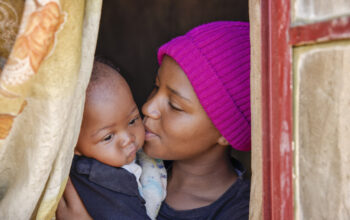Dialogue on global diabetes care with James Anderson: What is needed as we mark another World Diabetes Day?
For World Diabetes Day on 14 November, Ann-Lise Mikolajczak, Associate Manager, Value and Access and James Anderson, Executive Director of Global Health, sat down to discuss global diabetes care. This Q&A was developed in collaboration with HYPER Network, a platform for young industry professionals.
Ann-Lise: The WHO Global Diabetes Compact has the vision of reducing the risk of diabetes and ensuring that all people who are diagnosed with diabetes have access to equitable, comprehensive, affordable, and quality treatment and care. It was launched earlier this year in April.
What was IFPMA’s view on the launch of the Compact, and from your point of view, what needs to be done to achieve its vision?
James: In February 2021, WHO organized the “first-ever” Private Sector Dialogue on Diabetes, for which we – IFPMA, representing the global biopharmaceutical industry – were active contributors.
When the Compact was launched in April, we were encouraged by WHO’s statements that centred public-private partnerships to achieve a shared agenda and make an urgent and immediate impact on the lives of people living with diabetes[1]. The aim was to replicate the unprecedented multi-sectoral effort seen in the COVID-19 situation and adapt it to the diabetes context.
We have since seen that these multisectoral partnerships have moved at a much slower pace. Having said that, we continue to believe that that it is critically important to maximize long-term positive impacts on the lives of PLWDs by working together, and that WHO plays an essential convening role.
Today, what would you say PLWDs in lower-resource settings need for improved diabetes care?
People living with (or at risk of) diabetes need access to comprehensive, affordable, quality diabetes care. Insulin represents an important component – but just one of many – for managing this multi-faceted disease. Other components include:
- Patient/HCP awareness of diabetes and prevention strategies
- Early diagnosis
- Health system capacity, including training of healthcare professionals
- Functional supply chains
- Patient information and education towards better diabetes control
- And appropriate regulatory approval and prescription policies, so that PLWDs can get access to the care they need close to where they live and work.
Thanks, very interesting. We could also add the uptake of digital tools for improving prevention and management of diabetes and its co-morbidities, incl. the self-management of the condition, and strengthening the dialogue between HCPs or community workers and PLWDs.
Actually, this prevention angle is even more important for type 2 diabetes as it can prevent people at risk of developing it. Speaking of type 2 diabetes, what do you think of the recent inclusion of SGLT-2 inhibitors and analogue insulins in the WHO Essential Medicines List?
We welcome their addition, and this demonstrates that diabetes care goes largely beyond human insulins alone. The focus on type 2 diabetes is something that we pushed for at the WHO HQ level over the last year, so we look forward to collaborating with WHO and other stakeholders to find joint solutions to improve access to these products in lower-resource settings.
In September, WHO launched a public consultation on its proposed global targets for diabetes. How are these targets relevant?
In general, proper global targets can help drive alignment and focus on meaningful actions that can have a significant “on the ground” impact for PLWDs, as has been the case in other disease areas such as HIV/AIDS. They can motivate member states to accelerate investments and actions that are urgently required to improve the lives of PLWDs.
Having said that, global targets should be based on evidence and be realistic and achievable in order to not create a reverse effect and demotivate governments to step up efforts. We cannot have targets for the sake of targets.
I wanted to flag a particular point. We have taken note – in the WHO proposal – of a target set for 100% of people with type 1 diabetes to have access to insulin and blood glucose self-monitoring, which we have not seen before in any global health targets. Is this realistic and achievable?
I don’t think so. Setting 100% targets for global health outcomes is not something we see often, and, in the diabetes context, there are so many complex barriers to access that a 100% access target seems quite “pie in the sky.”
In any case, country ownership is critical for success. The achievement of targets should stem from national strategies and actions that are measurable with quality data, which we know is a challenge in many countries. Targets should also be linked to clear action plans to build health system capacity and increase resources to improve the lives of PLWDs.
WHO is stepping up its efforts on a new global reporting mechanism for all types of medicines. What’s your reaction to that?
Our industry has been reporting on various access programs and initiatives for many years. To name a few, the Access to Medicines Index, the UN Global Compact, the Access Accelerated Open Platform, and the Access Observatory, have been widely used to report on company initiatives.
We have gained valuable insights from our experience and noted a number of challenges, such as weak data infrastructure and data-gathering burden on local health workforces. We’d recommend to the WHO that they:
- Leverage existing reporting mechanisms and data sources
- Provide capacity building for local data collectors
- And link the reporting mechanism to the new global diabetes targets, so that all stakeholders (including governments) are held accountable for improving the lives of PLWDs.
Do you see any gaps in the current reporting mechanisms?
A critical gap that needs to be addressed is the reporting to be made by the biosimilar, medical devices, and diagnostic industries, which are currently not included in existing international reporting mechanisms.
Let’s move to another topic of interest. We hear in the global health community – WHO included – voices pinpointing the high prices of insulins as the main barrier to access in LMICs. What is the industry doing to overcome this challenge?
IFPMA has conducted research to identify the real barriers to access to diabetes care on the ground. Many factors are impeding it, and pricing issues were only one element of a complex ecosystem. This was demonstrated by local access initiatives, where new pricing approaches alone were not sufficient to effectively ensure timely access to care.
Affordability of health products at large – incl. consumables, blood glucose monitoring devices etc – were an area of concern. The high prices experienced by end users, meaning the patients, are observed at their care facilities.
And these patients’ prices are the result of the ex-manufacturer price and mark-ups by government agencies, distributors, and other stakeholders along the value chain, right?
Exactly.
A recent study by PATH found that 85% of the total cost that PLWDs pay in Kenya and Senegal is due to insulin delivery and glucose measurement devices. Another one found that supply chain price markups massively impact the price of medicines in all sector.
An analysis published by the IQVIA Institute showed that the ex-manufacturer insulin cost per day is consistently low across 32 LMICs. It also showed that there is no clear correlation between the number of insulin suppliers, insulin pricing and affordability, and availability for patients. This analysis calls into question the oft-repeated claim that “high prices of insulin” are due to the pricing practices of the three main insulin manufacturers worldwide.
I have another question that I would like to ask you: What is the biopharmaceutical industry doing to advance access to diabetes care in LMICs?
Our companies have been involved for many years in multi-stakeholder initiatives to improve access for PLWDs in LMICs. This year, IFPMA identified four activities that would make the greatest difference for people living with (or at risk of developing) diabetes:
- Develop supply chain and co-packaging solutions to facilitate the supply of diabetes health products
- Explore innovative aggregated supply and demand mechanisms
- Advance regulatory progress, including prequalification of human insulin and thermostability studies
- And scale-up digital health innovations tailored to local needs.
IFPMA member companies also invest in multi-stakeholder partnerships with governments, key local diabetes stakeholders, and highly respected NGOs to jointly work on improving the lives of PLWDs in lower-resource settings.
Lastly and I think we can conclude soon: What would be your wish to sustainably improve the lives of PLWDs, and especially in LMICs?
Multi-stakeholder collaborations in diabetes have the potential to enable substantive progress.
Looking ahead, our industry is eager to collaborate with all stakeholders to co-create the integrated and impactful solutions that PLWDs need.
We are committed to work in collaboration with WHO, governments, and other stakeholders, but these stakeholders also need to do their essential parts, by:
- Providing increased financing for diabetes prevention and quality care
- Enacting fit-for-purpose regulatory approval frameworks and policies to ensure appropriate products are readily available to patients
- And building properly equipped and managed supply chain infrastructures
And also: we need to jointly
- Provide healthcare professionals and community health workers with the right tools & training
- And empower people with the quality information they need to prevent and/or manage their condition.
Absolutely.
Thank you so much for the chat, James. I wish you a lovely rest of the day.
A short video captures some of their discussion. Individual clips were shared in the week leading up to World Diabetes Day on HYPER Network’s LinkedIn.
Event recording
Authors







